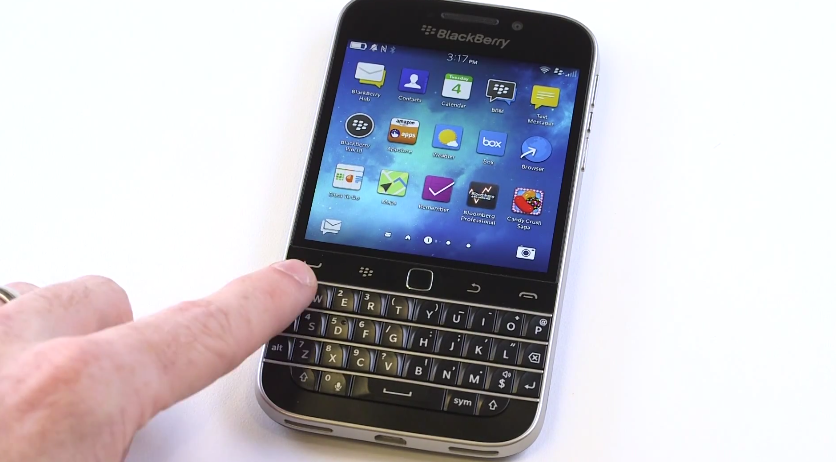
Welcome to Tête-à-Tête, a series where two of our writers converse on interesting topics in the mobile landscape — through chat. Think of it as a podcast for readers.
This week, Daniel and Douglas discuss the appeal of the BlackBerry Classic.
Douglas Soltys: Daniel, brave Daniel, help me to understand. While sifting through the numbers this morning, I was flabbergasted to learn that “BlackBerry Classic” was the second most popular search term for the ‘Syrup last month (the top search being “Daniel Bader how tall”).
Now, granted, we are the biggest (and best) mobile site in Canada, the home of BlackBerry, and located in snowy Toronto, the home of Bay Street, BlackBerry’s first conquered domain. But even if every businessperson who was craved a BlackBerry in 2004 suddenly does so again in 2014, that still doesn’t account for the interest. So what the heck is going on?
I’m well on the record as stating that the Classic is another iteration of the same device BlackBerry has been making for years. It’s not only me, however, it’s BlackBerry itself, who has been very forthright that the Classic is intended for legacy BlackBerry users interested in a targeted update to what they already have. Considering BlackBerry’s current global marketshare, that’s enough to bring a tidy profit, but not much more. So what the heck is going on?
In moments of quiet reflection, I’m lead to think that if BlackBerry had created the same device and called it the ‘Q75’ few would be interested. But in dubbing it the ‘Classic’, BlackBerry has adopted the mantle of the past, and that’s what interests. I’m reminded of a similar fevered state around the remake of the Motorola RAZR, a line of devices that was once synonymous with the term cell phone. Is that what’s happening here?
Daniel Bader: Invoking the past is not enough for companies to relive it, especially when the forebear of the product in question — the Bold 9900 — represented the beginning of BlackBerry’s downfall. The Classic is, from what I’ve seen, “classic” John Chen: a candid, transparent appeal to the legacy customer base he’s badly in danger of losing. The Classic is less designed than resurrected; from what I’ve seen, every element of the design and functionality has been informed by RIM circa 2011.
But not only is the market so far removed from that time as to be unrecognizable, BlackBerry as a company is far less bloated, confused and desperate. With the Passport as its flagship and the various numbered models hanging on for backup, the Classic can play two roles: it gives Bold 9900 users a clear upgrade path, and it takes the onus off the disappointing Q10 from appealing to those customers.
Interest in the Classic is coming from outside the business-centric sphere that courted the Passport upon its announcement; people miss that Bold keyboard and quick-access tool belt, and want the best of both worlds. They want the dead-quick communications speeds of the 9900 with the app support of a modern OS. I’m hoping the Classic, in appealing to both sides, doesn’t fail everyone in the process. Do you think it will?
Douglas: Sorry, while you were describing the Classic I blacked out and started thinking of the BlackBerry Q10, which delivered essentially the same pitch.
I get antsy with the idea of ‘best of both worlds’ designs. We talk all the time about the choices that hardware manufacturers have to make in their designs, their concessions to cost and physics, and when concessions are not imposed at the outset, they are often experienced in the hand. You are right to say that the Classic is a phone resurrected, but more like Frankenstein’s monster than Lazarus: it’s a menu-based input design being grafted onto a modern OS intended to be all-touch, built by hardware and software teams that had little to do with the 9900 (as tends to happen with mass departures and layoffs), and manufactured in China. The Classic isn’t a comeback device, it’s a facsimile, built to replicate the original experience, but not from the originators of that experience. It’s Journey’s Greatest Hits, sung by Arnel Pineda; it’s a Black Mirror episode.
The Passport, as a fresh reimagining of what a smartphone could be, didn’t get everything right, but that’s a matter of refinement – I’m excited by what future iterations might be. The Classic, to its name, is promising a mix of the past and the present. Which means it’s not the future, for BlackBerry, or for anybody else else.
Daniel: I love Black Mirror, and I also loved my Bold 9900. I have no doubt that upon immediately holding the Classic a wave of nostalgia will hit me like an Aaron Sorkin monologue: technically beautiful but soulless and meant to appeal to a very exclusive club.
The difference between the Bold 9900 and the Classic is in the intervening years BlackBerry has finally realized it has nothing to prove. The Bold was meant to be a consumer device for everyone; the Classic is meant to be a slightly-improved facsimile of an older product that appeals to a select exclusive group. The products are similar, the intentions very different.
And that’s why I think the Classic will be a success; low expectations are built into the product’s DNA.
MobileSyrup may earn a commission from purchases made via our links, which helps fund the journalism we provide free on our website. These links do not influence our editorial content. Support us here.


